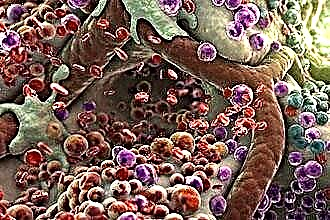Tomography is one of the most informative diagnostic methods, which allows you to determine the nature of the structure of any tissue and organ, based on the physical ability of an atom to change its position in a field. The cardiac MRI procedure does not initially require the introduction of contrast agents, since blood serves as an organic contrast. In this case, the image has a high resolution and allows you to objectively assess the state of the circulatory system.
Physical basis of the method
The basic principle of the MRI machine Is nuclear magnetic resonance. Let's consider this concept from a physical point of view.
The human body consists of atoms, neutrons and protons act as their charged particles. The particles rotate randomly inside the atomic nucleus, generating an internal magnetic field that can interact with an external magnetic field. As a result of this process, the protons line up in a specific sequence. The tomograph creates an energy impulse close to the rate of the protons' own rotation (Larmor frequency). This contributes to the change in the position of the particles and their synchronous rotation.
The protons of the internal magnetic field, under the influence of energy, gradually change their position and line up in an order similar to the external field. This is referred to as "relaxation". There are two relaxation times: T1 and T2. The concentration of nuclei and the relaxation time determine the magnitude of the spectrum and the brightness of the image.
Magnetic resonance imaging is suitable for visualization of soft tissues, since anatomical structures with a small number of protons (bones, air) always have a weak signal, therefore they are depicted as dark. Liquids, in particular water, can appear both light and dark, depending on the period (T1 or T2).
Additional research options
An additional value of MRI is the ability to enhance the sensitivity of the technique by introducing contrast compounds. The most widely used is gadolinium. The contrast builds up in tissues, making it possible to diagnose tumors and metastases. It is also used in cardiac practice to recognize aneurysms, defects and other vascular anomalies.
There are specific MRI studies (magnetic resonance imaging) of the cardiovascular system.
- MR angiography is a highly effective method for the rapid assessment of blood flow in the aorta and peripheral arteries. Magnetic resonance imaging allows you to view images of blood vessels in two-dimensional and three-dimensional modes.
- MR spectroscopy - based on the formation of a spectrum from the nuclei of hydrogen and phosphorus, which is important for assessing biochemical processes in the myocardium. The spectrum demonstrates the relative concentrations of adenosine triphosphate (ATP) and phosphocreatine (PCr), enzymes that mark damage to the heart muscle. A decrease in the concentration of PKr in comparison with ATP indicates myocardial ischemia.
- Phase velocity mapping is a resonant technique similar to cardiac ultrasound. It allows you to visualize blood flow, calculate the value of stroke volume and cardiac output at the level of the aortic valve, and also determine the presence of defects of the interventricular or interatrial septa.
Indications
The main indication for the study is the need for detailed visualization of the circulatory system with an inaccurate result of ultrasound of the heart. Also, the method can be used as an alternative to multislice computed tomography (MSCT).
In cardiological practice, it is important to correctly calculate the mass of the myocardium, chamber volumes, ejection fraction, and also to establish the cause of the development and progression of heart failure, which is excellently shown by MRI of the heart.

The high resolution tomography allows for an optimal assessment of the contractile function of the heart. Breath-holding techniques help track the location of the coronary artery. The method makes it possible to assess the operation of the valve and indicate a return flow of blood or stenosis. Tomography is the gold standard for assessing pericardial thickness. The method allows obtaining clear images of the aorta, pulmonary arteries and veins, assessing myocardial perfusion.
Indications for MRI of the heart are formed when the following conditions are suspected:
- aneurysm and pseudoaneurysm of the ventricle;
- dilated and hypertrophic cardiomyopathy;
- congenital and acquired heart defects;
- myocarditis;
- cardiac fibrosis;
- arrhythmogenic myocardial dysplasia;
- hemochromatosis - infiltrative cardiomyopathy, in which iron accumulates in the myocardium;
- remodeling of the heart;
- amyloidosis;
- sarcoidosis;
- Chagas disease;
- tumors in the heart are also easily detectable, which helps to recognize the disease in the early stages.
Informativeness
The information content of the method directly depends on the type of device used, its power and settings.
An open (low-field) tomograph is recommended for examining patients with claustrophobia and other conditions that complicate the process. The power of the apparatus is usually between 0.23 and 0.5 Tesla. Whether to do an MRI of the heart with such weak settings is a question of rationality, because the image quality is low.
High-field installations have a capacity of 1-1.5-3 Tesla, which provides thin sections and, therefore, a more detailed picture. In addition, this type of apparatus works much faster.
In what cases is the patient prohibited from performing tomography?

The main danger of the study is the likelihood of provoking a situation that threatens the patient's life. ... Absolute contraindications:
- the presence of a pacemaker;
- installed insulin pumps;
- middle ear implants;
- the presence of artificial heart valves;
- metal braces - especially dangerous on cerebral vessels, as damage to the vascular wall and bleeding are likely.
Relative contraindications:
- stents in the coronary arteries;
- artificial valves in the heart;
- some models of cava filters;
- prosthetic joints;
- metal brackets, shards;
- dentures or metal teeth;
- the need to maintain vital functions mechanically (for example, artificial ventilation of the lungs);
- mental disorders, including claustrophobia;
- the first trimester of pregnancy - there is no exact data on the dangers of manipulation, but it is recommended to avoid research in the early stages.
If contrast is injected during magnetic resonance imaging of the heart muscle, the following contraindications are added:
- individual intolerance to the components of the contrast agent;
- severe renal failure;
- pregnancy at any time;
- hemolytic anemia.
Conclusions
Despite the high cost, cardiac tomography is widely used in modern medicine. The method is recognized as the most reliable for assessing the structure and function of the right and left ventricles, great and peripheral vessels. But it is worth noting that MRI is not an initial study in the diagnosis of cardiovascular diseases, but is carried out more often to clarify the data of echocardiography.



